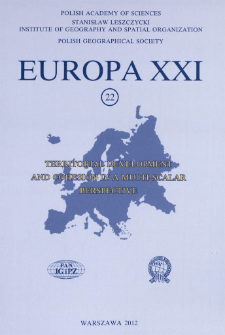
Object
Title: Trapped Between Concentration and Cohesion? Overcoming the Dichotomous Nature of Strategic Spatial Development within the Baltic Sea Region
Subtitle:
Publisher:
Place of publishing:
Description:
Type of object:
References:
1. Baltic Development Forum, 2007, State of the Region report 2006. The Baltic Sea Region – Top ofEurope in Global Competition, Copenhagen/Helsinki.
2. Baltic Development Forum, 2008, State of the Region report 2007. The Baltic Sea Region as a Placeto Do Business, Copenhagen/Helsinki.
3. Dijkstra L., Poelman H., 2011, Regional typologies: a compilation, Regional Focus n° 01/2011,Brussels: European Commission, DG Regio.
4. ESPON, 2011, SGPTDE - Secondary Growth Poles in Territorial Development in Europe, AppliedResearch 2013/1/11, Interim Report Version 28/02/2011.
5. European Commission, 2008, Green Paper on Territorial Cohesion. Turning territorial diversity intostrength, Brussels, 6.10.2008, COM(2008) 616 final.
6. European Commission, 2010, Investing in Europe’s Future. 5th Report on Economic, Social andTerritorial Cohesion, Luxembourg: Publications Office of the European Union.
7. Groth N. (ed.), 2008, East West Window. Working Group 1: Regional Integration: Russia in the BalticSea Region. Copenhagen.
8. Hanell T., 2009, Economic Development of the BSR – Stubborn patterns despite rapid change,Informationen zur Raumentwicklung, Raumplanung und Entwicklung in der Ostseeregion, heft8/9.2009, Bundesamt für Bauwesen und Raumordnung.
9. Hanell T., Neubauer J., 2005, Cities of the Baltic Sea Region – Development Trends at the Turn of theMillennium, Stockholm, Nordregio Report.
10. Hanell T., Neubauer J., 2006, Geographies of Knowledge Production in Europe, Nordregio WP2006:3, Stockholm: Nordregio.
11. Schmitt P. et al., 2008, Exploring the Baltic Sea Region – On territorial capital and spatial integration,Stockholm: Nordregio Report.
12. Eurostat: http://epp.eurostat.ec.europa.eu
13. OECD: http://www.oecd.org
14. United Nations Commodity Trade Statistics: http://www.un.org/
15. World Bank: http://www.worldbank.org/
Relation:
Volume:
Start page:
End page:
Detailed Resource Type:
Format:
File size 3 MB ; application/pdf
Resource Identifier:
oai:rcin.org.pl:31084 ; 1429-7132 ; 10.7163/Eu21.2012.22.4
Source:
CBGiOŚ. IGiPZ PAN, call nos.: Cz.6406, Cz.6407 ; click here to follow the link
Language:
Rights:
Terms of use:
Copyright-protected material. May be used within the limits of statutory user freedoms
Digitizing institution:
Institute of Geography and Spatial Organization of the Polish Academy of Sciences
Original in:
Projects co-financed by:
European Union. European Regional Development Fund ; Programme Innovative Economy, 2010-2014, Priority Axis 2. R&D infrastructure
Access:
Object collections:
- Digital Repository of Scientific Institutes > Partners' collections > Institute of Geography and Spatial Organization PAS (IGiPZ PAN) > Publications of IGiPZ PAN and employees
- Digital Repository of Scientific Institutes > Partners' collections > Institute of Geography and Spatial Organization PAS (IGiPZ PAN) > Library > Series/Journals/Periodics
- Digital Repository of Scientific Institutes > Literature > Journals/Articles
Last modified:
Oct 2, 2020
In our library since:
Jul 15, 2013
Number of object content downloads / hits:
788
All available object's versions:
https://rcin.org.pl/publication/50259
Show description in RDF format:
Show description in RDFa format:
Show description in OAI-PMH format:
Objects Similar
Szumilin, Krystyna Krause, Sonja
Fedorov, Gennady M Mikhaylov, Andrey S
Masik, Grzegorz
Lipińska, Aleksandra
Woźnica, Andrzej Józef
Marszał, Tadeusz
Czyż, Teresa

 INSTYTUT ARCHEOLOGII I ETNOLOGII POLSKIEJ AKADEMII NAUK
INSTYTUT ARCHEOLOGII I ETNOLOGII POLSKIEJ AKADEMII NAUK
 INSTYTUT BADAŃ LITERACKICH POLSKIEJ AKADEMII NAUK
INSTYTUT BADAŃ LITERACKICH POLSKIEJ AKADEMII NAUK
 INSTYTUT BADAWCZY LEŚNICTWA
INSTYTUT BADAWCZY LEŚNICTWA
 INSTYTUT BIOLOGII DOŚWIADCZALNEJ IM. MARCELEGO NENCKIEGO POLSKIEJ AKADEMII NAUK
INSTYTUT BIOLOGII DOŚWIADCZALNEJ IM. MARCELEGO NENCKIEGO POLSKIEJ AKADEMII NAUK
 INSTYTUT BIOLOGII SSAKÓW POLSKIEJ AKADEMII NAUK
INSTYTUT BIOLOGII SSAKÓW POLSKIEJ AKADEMII NAUK
 INSTYTUT CHEMII FIZYCZNEJ PAN
INSTYTUT CHEMII FIZYCZNEJ PAN
 INSTYTUT CHEMII ORGANICZNEJ PAN
INSTYTUT CHEMII ORGANICZNEJ PAN
 INSTYTUT FILOZOFII I SOCJOLOGII PAN
INSTYTUT FILOZOFII I SOCJOLOGII PAN
 INSTYTUT GEOGRAFII I PRZESTRZENNEGO ZAGOSPODAROWANIA PAN
INSTYTUT GEOGRAFII I PRZESTRZENNEGO ZAGOSPODAROWANIA PAN
 INSTYTUT HISTORII im. TADEUSZA MANTEUFFLA POLSKIEJ AKADEMII NAUK
INSTYTUT HISTORII im. TADEUSZA MANTEUFFLA POLSKIEJ AKADEMII NAUK
 INSTYTUT JĘZYKA POLSKIEGO POLSKIEJ AKADEMII NAUK
INSTYTUT JĘZYKA POLSKIEGO POLSKIEJ AKADEMII NAUK
 INSTYTUT MATEMATYCZNY PAN
INSTYTUT MATEMATYCZNY PAN
 INSTYTUT MEDYCYNY DOŚWIADCZALNEJ I KLINICZNEJ IM.MIROSŁAWA MOSSAKOWSKIEGO POLSKIEJ AKADEMII NAUK
INSTYTUT MEDYCYNY DOŚWIADCZALNEJ I KLINICZNEJ IM.MIROSŁAWA MOSSAKOWSKIEGO POLSKIEJ AKADEMII NAUK
 INSTYTUT PODSTAWOWYCH PROBLEMÓW TECHNIKI PAN
INSTYTUT PODSTAWOWYCH PROBLEMÓW TECHNIKI PAN
 INSTYTUT SLAWISTYKI PAN
INSTYTUT SLAWISTYKI PAN
 SIEĆ BADAWCZA ŁUKASIEWICZ - INSTYTUT TECHNOLOGII MATERIAŁÓW ELEKTRONICZNYCH
SIEĆ BADAWCZA ŁUKASIEWICZ - INSTYTUT TECHNOLOGII MATERIAŁÓW ELEKTRONICZNYCH
 MUZEUM I INSTYTUT ZOOLOGII POLSKIEJ AKADEMII NAUK
MUZEUM I INSTYTUT ZOOLOGII POLSKIEJ AKADEMII NAUK
 INSTYTUT BADAŃ SYSTEMOWYCH PAN
INSTYTUT BADAŃ SYSTEMOWYCH PAN
 INSTYTUT BOTANIKI IM. WŁADYSŁAWA SZAFERA POLSKIEJ AKADEMII NAUK
INSTYTUT BOTANIKI IM. WŁADYSŁAWA SZAFERA POLSKIEJ AKADEMII NAUK


































